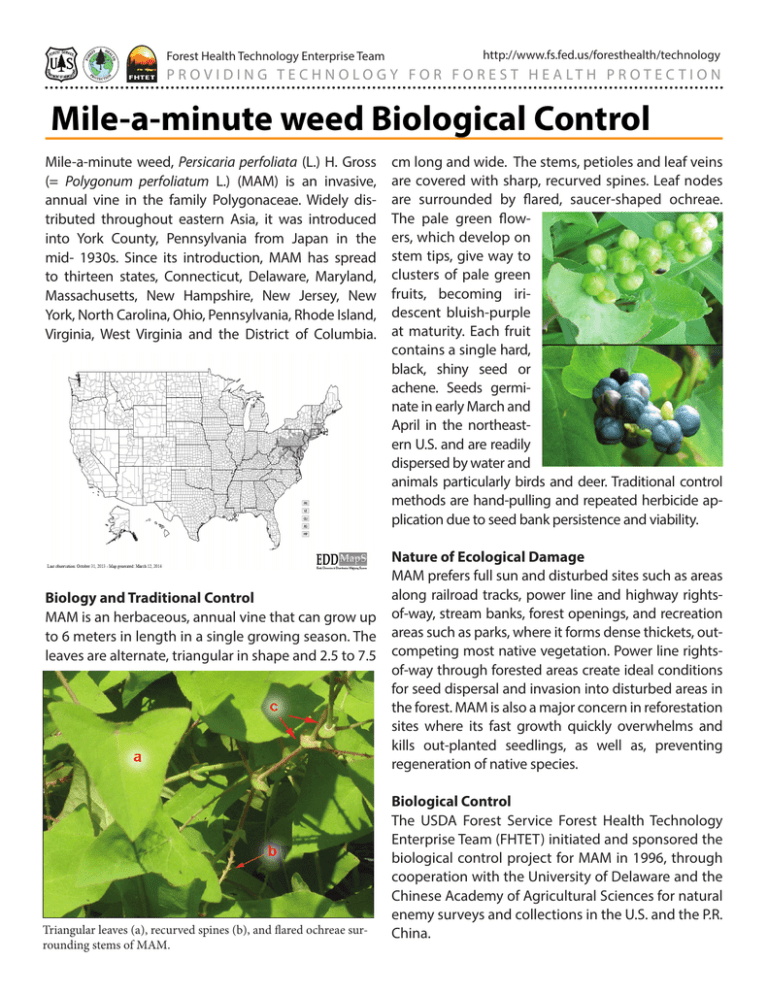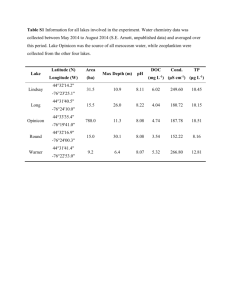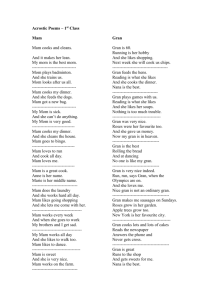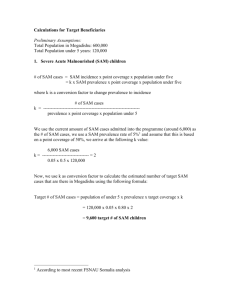Mile-a-minute weed Biological Control
advertisement

Forest Health Technology Enterprise Team http://www.fs.fed.us/foresthealth/technology P R O V I D I N G T E C H N O L O G Y F O R F O R E S T H E A LT H P R O T E C T I O N Mile-a-minute weed Biological Control Mile-a-minute weed, Persicaria perfoliata (L.) H. Gross (= Polygonum perfoliatum L.) (MAM) is an invasive, annual vine in the family Polygonaceae. Widely distributed throughout eastern Asia, it was introduced into York County, Pennsylvania from Japan in the mid- 1930s. Since its introduction, MAM has spread to thirteen states, Connecticut, Delaware, Maryland, Massachusetts, New Hampshire, New Jersey, New York, North Carolina, Ohio, Pennsylvania, Rhode Island, Virginia, West Virginia and the District of Columbia. cm long and wide. The stems, petioles and leaf veins are covered with sharp, recurved spines. Leaf nodes are surrounded by flared, saucer-shaped ochreae. The pale green flowers, which develop on stem tips, give way to clusters of pale green fruits, becoming iridescent bluish-purple at maturity. Each fruit contains a single hard, black, shiny seed or achene. Seeds germinate in early March and April in the northeastern U.S. and are readily dispersed by water and animals particularly birds and deer. Traditional control methods are hand-pulling and repeated herbicide application due to seed bank persistence and viability. Nature of Ecological Damage MAM prefers full sun and disturbed sites such as areas along railroad tracks, power line and highway rightsBiology and Traditional Control MAM is an herbaceous, annual vine that can grow up of-way, stream banks, forest openings, and recreation to 6 meters in length in a single growing season. The areas such as parks, where it forms dense thickets, outleaves are alternate, triangular in shape and 2.5 to 7.5 competing most native vegetation. Power line rightsof-way through forested areas create ideal conditions for seed dispersal and invasion into disturbed areas in the forest. MAM is also a major concern in reforestation sites where its fast growth quickly overwhelms and kills out-planted seedlings, as well as, preventing regeneration of native species. Triangular leaves (a), recurved spines (b), and flared ochreae surrounding stems of MAM. Biological Control The USDA Forest Service Forest Health Technology Enterprise Team (FHTET) initiated and sponsored the biological control project for MAM in 1996, through cooperation with the University of Delaware and the Chinese Academy of Agricultural Sciences for natural enemy surveys and collections in the U.S. and the P.R. China. Forest Health Technology Enterprise Team http://www.fs.fed.us/foresthealth/technology P R O V I D I N G T E C H N O L O G Y F O R F O R E S T H E A LT H P R O T E C T I O N MAM infestation out-competes native vegetation. From 1997 through 2000, over 2,000 specimens, representing 7 orders and 110 families, were recovered from MAM on 93 sites in four eastern states in the U.S. However, none of the native natural enemies were effective in suppressing MAM populations and no insects that attack the seeds or roots were recovered. Between 1996 and 2001 exploration for natural enemies in 23 northeastern provinces in P.R. China yielded 111 insect species from six orders and 29 families. Through subsequent host-range testing, a weevil, Rhinoncomimus latipes Korotyaev (Coleoptera: Curculionidae) was selected as the most promising biological control agent. In 1999 and 2000, the weevil was imported from China to the Beneficial Insects Introduction Research quarantine facility in Newark, Delaware. Host range testing by scientists at Adult weevil, Rhinoncomimus latipes. the University of Delaware confirmed R. latipes to be host specific to MAM only. The adult R. latipes lays eggs on leaves, stems and buds. The larvae bore into the stems at the nodes and feed internally. Once mature, they crawl or drop to the soil and pupate. Adults emerge from the soil, crawl up MAM plants, mate and begin laying eggs. In 2004–2005, surveys and collections of natural enemies of MAM were conducted in Japan. R. latipes was the most promising natural enemy of the 50 herbivore insect species collected. R. latipes was approved for release by USDA APHIS in 2004. In the spring of 2004 the NJ Department of Agriculture Philip Alampi Beneficial Insect Laboratory entered into a cooperative agreement with FHTET to mass rear the weevil. In July 2004, the first release of 200 weevils took place in White Clay Creek State Park, New Castle, Delaware, with subsequent releases in 2004 in NJ. Since then annual released weevils/states have increased annually from 12, 509 in three states in 2005 to 76,680 in 11 states in 2012, and 86,060 in ten states in 2013. A total of 535,562 weevils have been released in CT, DE, MA, MD, NC, NJ, NY, OH, PA, RI, VA, and WV including islands in the middle of the Ohio River. Post release monitoring techniques and restoration studies have also been conducted by scientists at the University of Delaware (Cuttings and Hough-Goldstein, 2013; Lake et al., 2011; Lake et al., 2014). Rhinoncomimus latipes larva feeding in MAM stem. http://www.fs.fed.us/foresthealth/technology Forest Health Technology Enterprise Team P R O V I D I N G T E C H N O L O G Y F O R F O R E S T H E A LT H P R O T E C T I O N An annual cooperator’s meeting for biological control of MAM has been held each year beginning in 2006 to exchange and update information on MAM distribution, biological control and related research. A technology transfer publication “Biology and Biological Control of Milea-Minute Weed” was published in November 2008 (Hough-Goldstein et al., 2008), to document the progress and results of this biological control effort. Outlook R. latipes continues to spread and impact populations of MAM. Monitored release sites showed reductions in spring densities of MAM to 25% or less of what they had been within 1-3 years following weevil release (Hough-Goldstein et al. 2009). However, the impact of weevils can vary depending on weather conditions: cool, wet weather generally favors rampant weed growth with reduced weevil populations (Lake 2011, Berg 2014). Impacts also vary depending on the plant community that co-occurs with the weed. If strong native competitors are present, biological control alone can restore a desirable plant community, but if not, revegetation with native plants may be necessary along with weevils to suppress MAM and prevent invasion by other non-native invasive plants (Cutting and Hough-Goldstein 2013, Lake et al. 2014). Lake et al. have documented the increase of other invasive species (e.g. Microstegium vimineum (Japanese stilt grass)) following reduction of MAM populations on control sites. Indirect facilitation among invasive plants was found to be evident between invasive plant species. Restoration using selected native plant species incorporated with biological control and herbicide treatments into an integrated invasive F OR M O R E INFO RMAT I O N CON TAC T: Richard Reardon, Program Manager Biological Control and Biopesticide USDA Forest Service 180 Canfield Street Morgantown, WV 26505 Phone: 304-285-1566 Fax: 304-285-1564 E-mail: rreardon@fs.fed.us plant management program may be needed in the future to manage MAM. References Berg, S.H. 2014. Dispersal behavior of the weevil Rhinoncomimus latipes, and the influence of varying moisture and temperature conditions on the biological control of mile-a-minute weed. M.S. Thesis, University of Delaware, Newark. Cutting, K., and J. Hough-Goldstein. 2013. Integration of biological control and native seeding to restore invaded plant communities. Restoration Ecology 21:648-655. Hough-Goldstein, J., E. Lake, R. Reardon, and Y. Wu. 2008. Biology and biological control of mile-aminute weed. Technology Transfer Biological Control USDA Forest Service FHTET-2008-10. Hough-Goldstein, J., M. A. Mayer, W. Hudson, G. Robbins, P. Morrison, and R. Reardon. 2009. Monitored releases of Rhinoncomimus latipes (Coleoptera: Curculionidae), a biological control agent of mile-a-minute weed (Persicaria perfoliata), 2004-2008. Biological Control 51:450457. Lake, E. 2011. Biological Control of mile-a-minute weed, Persicaria perfoliata, and integrating weed management techniques to restore invaded sites. Ph.D. Dissertation, University of Delaware, Newark. Lake, E., J. Hough-Goldstein, and V. D’Amico. 2014. Integrating management techniques to restore sites invaded by mile-a-minute weed, Persicaria perfoliata. Restoration Ecology 22: (online first). DOI:10.1111/rec.12035.







